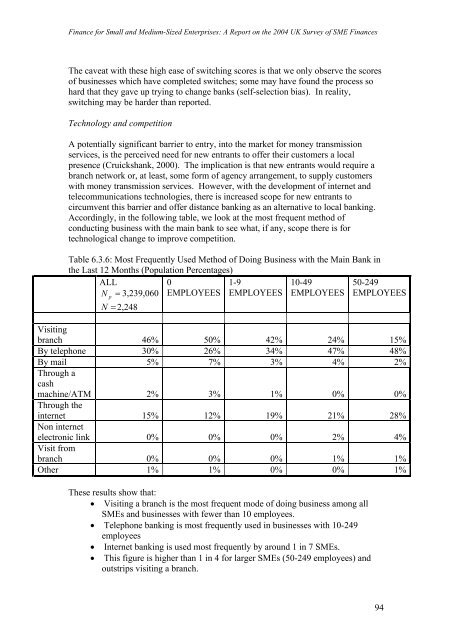Finance for Small and Medium-Sized Enterprises - DTI Home Page
Finance for Small and Medium-Sized Enterprises - DTI Home Page
Finance for Small and Medium-Sized Enterprises - DTI Home Page
You also want an ePaper? Increase the reach of your titles
YUMPU automatically turns print PDFs into web optimized ePapers that Google loves.
<strong>Finance</strong> <strong>for</strong> <strong>Small</strong> <strong>and</strong> <strong>Medium</strong>-<strong>Sized</strong> <strong>Enterprises</strong>: A Report on the 2004 UK Survey of SME <strong>Finance</strong>s<br />
The caveat with these high ease of switching scores is that we only observe the scores<br />
of businesses which have completed switches; some may have found the process so<br />
hard that they gave up trying to change banks (self-selection bias). In reality,<br />
switching may be harder than reported.<br />
Technology <strong>and</strong> competition<br />
A potentially significant barrier to entry, into the market <strong>for</strong> money transmission<br />
services, is the perceived need <strong>for</strong> new entrants to offer their customers a local<br />
presence (Cruickshank, 2000). The implication is that new entrants would require a<br />
branch<br />
network<br />
or, at least, some <strong>for</strong>m of agency arrangement, to supply customers<br />
with money transmission services. However, with the development of internet <strong>and</strong><br />
telecommunications technologies, there is increased scope <strong>for</strong> new entrants to<br />
circumvent this barrier <strong>and</strong> offer distance banking as an alternative to local banking.<br />
Accordingly, in the following table, we look at the most frequent method of<br />
conducting business with the main bank to see what, if any, scope there is <strong>for</strong><br />
technological change to improve competition.<br />
Table 6.3.6: Most Frequently Used Method of Doing Business with the Main Bank in<br />
the Last 12 Months (Population Percentages)<br />
ALL<br />
0<br />
1-9<br />
10-49 50-249<br />
N = 3,239,060 EMPLOYEES EMPLOYEES EMPLOYEES EMPLOYEES<br />
p<br />
N = 2,248<br />
Visiting<br />
branch 46% 50% 42% 24% 15%<br />
By telephone 30% 26% 34% 47% 48%<br />
By mail<br />
Through a<br />
cash<br />
5% 7% 3% 4% 2%<br />
machine /ATM 2% 3% 1% 0%<br />
0%<br />
Through the<br />
internet<br />
Non internet<br />
15% 12% 19% 21% 28%<br />
electronic link<br />
Visit from<br />
0% 0% 0% 2% 4%<br />
branch 0% 0% 0% 1%<br />
1%<br />
Other 1%<br />
1% 0% 0% 1%<br />
These results show that:<br />
• Visiting a branch is the most frequent mode of doing business among all<br />
SMEs <strong>and</strong><br />
businesses with fewer than 10 employees.<br />
• Telephone banking is most frequently used in businesses<br />
with 10-249<br />
employees<br />
• Internet banking is<br />
used most frequently by around 1 in 7 SMEs.<br />
• This figure is higher than 1 in 4 <strong>for</strong> larger SMEs (50-249 employees) <strong>and</strong><br />
outstrips visiting a branch.<br />
94















![Joint Report on Social Protection and Social Inclusion [2005]](https://img.yumpu.com/19580638/1/190x132/joint-report-on-social-protection-and-social-inclusion-2005.jpg?quality=85)
